Tips for choosing the best pastel paper
The truth about paper for soft pastel…?
It’s the most important part of the whole process, even as a beginner, actually, especially as a beginner.
Because the paper can be the difference between loving and hating soft pastel.
I lost count of the number of times people have said that they just don’t like soft pastel and then when I’ve given them a good pastel paper to try they have completely changed their minds. Some people also say they can’t possibly draw or use soft pastels or be ‘an artist’ either, but that’s another story for another day my friend.
Back to the paper…
Pastel paper can be generally classified into 4 (actually 5) different groups. I’m talking specialist pastel papers here, not mixed media papers.
Another truth about pastel paper is that you’ll only know what’s best for you when you try it. So TOP TIP No.1 get a sample pack of pastel papers. Online art shops like Jackson’s Art sell these packs, they save you a lot of money and you don’t end up with lots of pads full of paper they you’ll never use.

Here’s a chart showing you those groups:
Paper
textured surface- Canson Mi-Teintes
- Lenox 100 Paper
- Fabriano Tiziano
- Ingres Paper
- Murano Paper
Sanded
Gritty surface- Uart Paper
- Fisher 400
- Sennelier A La Carte
- Lux Archival
- Wallis Paper
Coated
manufactured coating- Pastelmat Card/Board
- Colourfix
- Canson Touch
Other
various coatings- Hahnemuhle Velour – Similar to velvet or felt with a short, fine pile like a carpet
- Ampersand Pastelbord Panel – marble dust finish
There are a lot of pastel papers and this can get very confusing for us all. But splitting them in to categories like this helps you understand them better and to know that similar paper groups are going to give you similar results.
So lets talk about what results you’ll get on each paper, then you can pick a group that suits your style.
Textured Pastel Papers
This is simple rough textured paper akin to sugar paper. In fact you can use sugar paper if that’s all you have and just want to get started. But if you don’t like it the reason is lkely that it doesn’t have enough texture or tooth. So you could try a good textured pastel paper like Canson Mi-Teintes which is double sided. One side textured and the other side is like a honeycomb texture. I used this a lot when i started with soft pastel and i really liked it for people portraits. But when i started wanting more and very fine detail it was really hard to achieve so I started experimenting with other papers. Another thing I didn’t like was that if it took a while to achieve to colour I was after the paper fibres would lift and I didn’t like the look of that. It’s been a few years since I’ve used Canson and my pastel skills have improved 10 fold in that time so may be it’s time for me to revisit 🙂 As you can tell, this is all about personal preference
Sanded Pastel Papers
These are akin to a sand paper like surface or a wet and dry sanded paper surface. The kind you’ll find in the hardware store. You can get different grit sanded paper from as fine as 800 GRIT to as course as 230 GRIT. You can get lots of layers on this paper and achieve great detail. It’s a good all round pastel paper. BUT you need to watch your fingers. You have to have a few layers of pastel on the sanded surface before you even think about using your fingers to blend or you’ll end up causing your fingers to bleed.
I mentioned the hardware store earlier. It’s a really good place to buy pastel paper. If you ask for wet and dry sanding paper – anything between 1000 GRIT and 1500 GRIT you’ll have yourself some really good practice paper and budget friendly too. Of course, it’s not archival or acid free meaning you wouldn’t want to use it for professional paintings but for practice it’s a really good option.
You can achieve a lot of detail on sanded papers or create loose impressionistic styles.
Coated Pastel Papers
These papers have been a game changer for many pastel artists (including me), especially artists who crave the detail. Pastelmat is my favourite, it allows lots of layers, vibrant colours and lets you achieve lots of fine details. I didn’t always love Pastelmat though. I found the colours were too vibrant and cartoon like but I realise now that the reason I didn’t like it was because I used the same technique as I was using on the textured papers and it just didn’t work the same. Now I love Pastelmat as I’ve found a different way of working with it.
Velour Pastel Papers
This was my paper of choice for a very long time! I found it exceptionally good for recreating fur details. Velour is made of tiny fibres like a soft velvety carpet. I bit like velvet. It creates a soft focus effect and allows you to add many layers. You have to rub the layers in really well or the pastel will just fall off the paper. It’s also much better when used with quality professional pastels like Unison Colour Soft Pastels or Terry Ludwig’s because the colour is much more vibrant.
Why did I stop using velour? I found myself striving for more and more detail and I was making my life a lot harder by trying to achieve that on a paper that is best for giving a soft focus effect.
Ampersand Pastelbord
I’ve never used this Pastelbord but it sounds very intriging, I have some and hope to report back soon. This is what the manufacturers say:
“Museum Series Pastelbord is a medium textured, highly absorbent surface designed for pastels. Pastelbord is crafted from our premium warp-resistant 1/8″ profile FSC-certified Hardbord™ that is protected with our proprietary Archiva-Seal™ and coated with an acid-free clay and gesso ground with a marble dust finish. Artists choose Pastelbord because the tooth of the marble dust finish holds more layers of pastel than paper and it is versatile enough to be used with wet and dry applications.”
See what Sylvia has to say about this paper below.
Make Your Own
You can make your own paper too on watercolour paper or mount board by applying a pastel ground made by companies like GOLDEN or Colorfix or you can mix pumice and gesso. The ground creates a textured, non-uniform surface so it’s good for less detailed, or impressionist / abstract work. If you are careful you can get a smoother surface. Robert Dutton – Pastel Artist create his own pastel paper or board using a glass ground, marble or slate dust and gesso,
I asked members of my Soft Pastel Facebook group to share their favourite pastel papers. You can see that there is such a wide variety of choice and opinion from the comments below.
Do you use a different pastel paper? What’s your favourite, let me know in the comments at the end of the post.
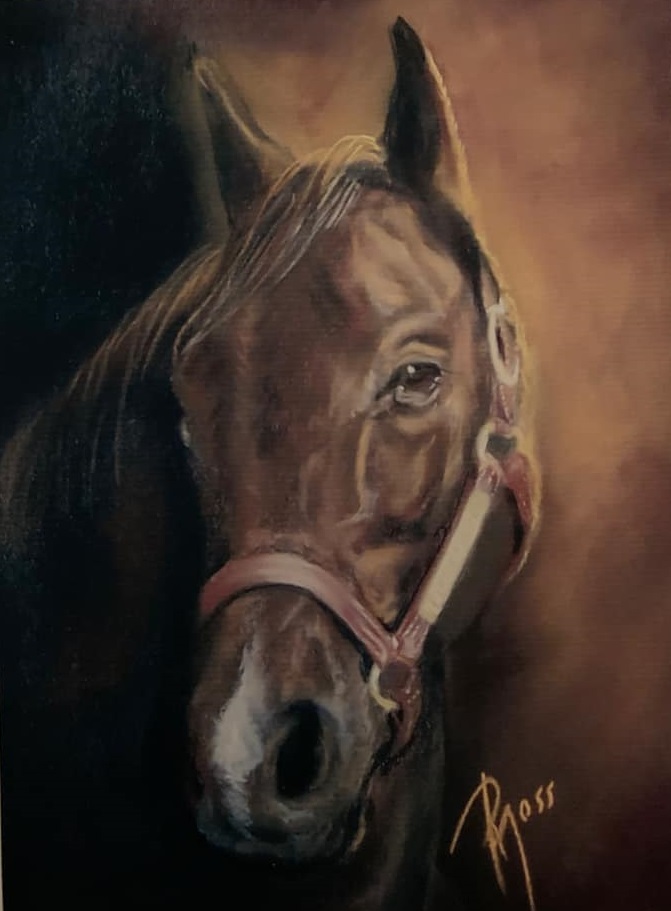
Art by Patricia A Nolan Moss on Canson Mi-Teintes
Patricia says: ‘I’ve used it forever, it’s very forgiving, it has two different sides to choose from and it’s reasonably priced. I’m very detail oriented… no problem with details on this paper. I guess I’m just used to it.’
Patricia makes a really good point here, getting to know the paper you use is key to using it well.
Art by Sable Viridariis on Watercolour Paper
Sable says: ‘I think I might be in the minority but it’s my favorite surface. It doesn’t take as many layers as pastelmat, but the manufacturers are generally very forthcoming with what they use in production of their product, and I have yet to get an answer about what adhesive is used to adhere the cork surface to the backing paper in pastelmat. I get it’s a new product and the production is a trade secret for them, but as an artist I want to know exactly what I’m using so I can know that it will last. I prefer Canson L’Aquarelle, cold pressed, 640 gsm. It’s rigid enough to be a fantastic support for the pastels, not too heavily toothed that it becomes difficult to fill, and 100% cotton so I know it will last. I sand the surface with a medium grit sandpaper to open the cotton fibers a bit and do a watercolor underpainting sometimes. It’s lovely.‘
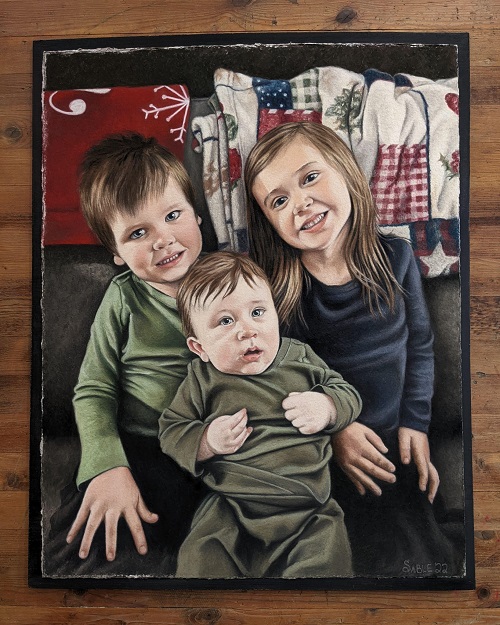
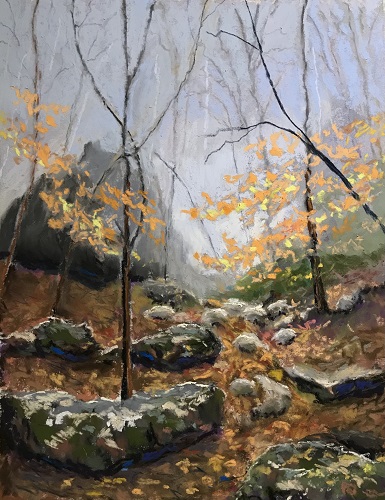
Art by Susan Hunter Guise on Lux Archival
Susan says: ‘LuxArchival is a 400 grit sanded paper. 100% cotton, archival. My husband bought a roll of it for me from Jackson’s. It comes in a cream colour. I do like that I can steam iron the back of it to take out any curl from the roll, and it stays flat. Someone said it was the closest thing to Kitty Wallis paper, I think. I haven’t tried UART’s 400 grit to compare. Both are good, I just prefer the UART 600 grit (I started out on 800 grit wet/dry automotive sandpaper)’
Art by Sue Kerrigan-Harris on Canson Mi-Teintes
Sue says: ‘This is a painting I did when I first started pastelling. It is the smoother side of Canson Mi-Teintes paper and this portrait lent itself really well to this paper. Her soft skin and silky hair glided on to the paper’
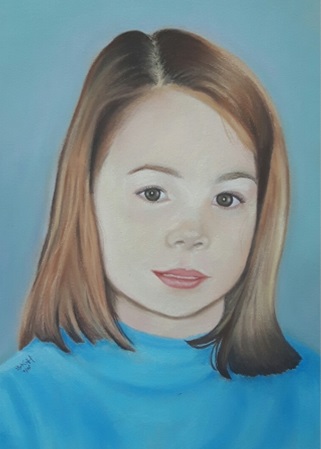
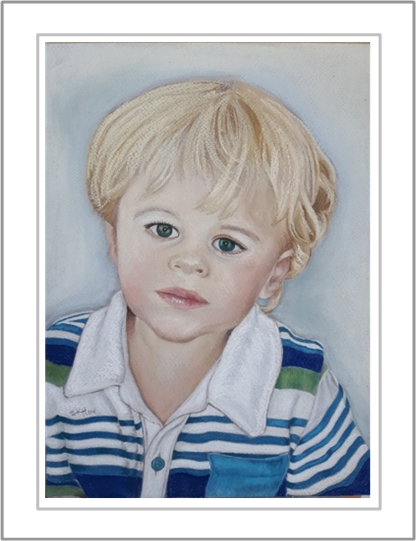
Art by Joanne Larner on Canson Mi-teinte Touch
Sue says: ‘My favourite is Canson Mi-teinte Touch. I like the texture which allows multiple layers and it comes in several colours so you can choose whichever suits your subject. I used to buy the cheap options but now realise quality paper and pastels make a tremendous difference. Here are some pastel paintings I’ve done with Canson Mi-Teinte Touch (see comments below too)’
Art by Martina Diez-Routh on Sennelier A La Carte
Sue says: ‘for me is because it catches the pigment very well with its teeth, and can put lots of layers. I don’t like that much Uart and Pastelmat and Miteintes, but have some pads of them and use them for smaller paintings. I do have some pastel boards that are okeish, but for me the best is La Carte Pastel. Also used the velvet boards, that are nice, but not that good for smudging…‘
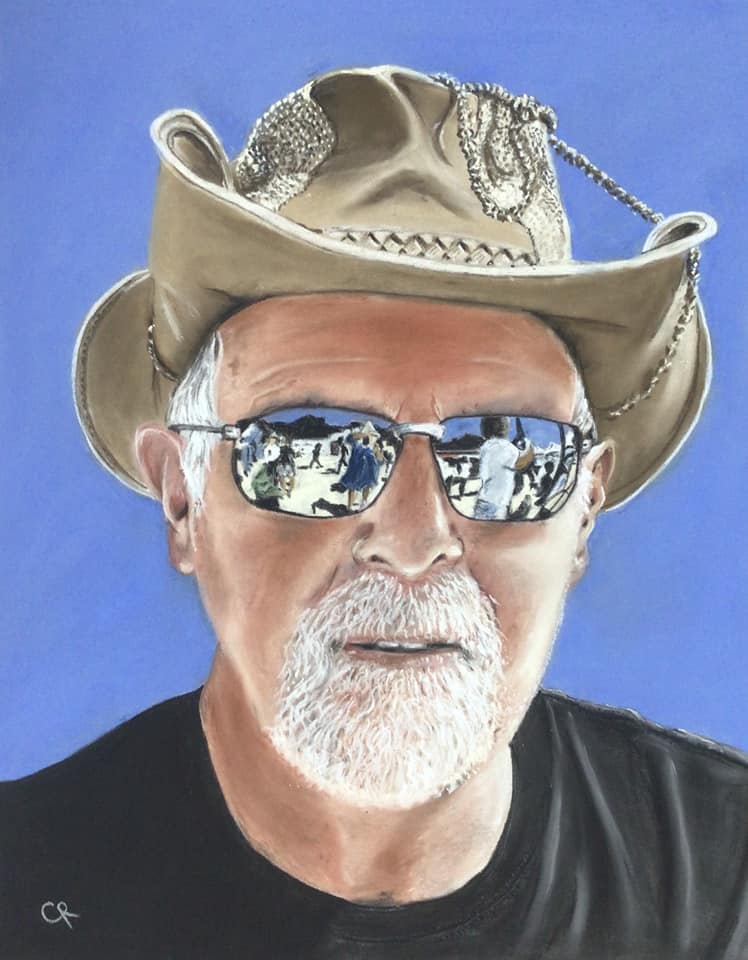

Art by Sue Kerrigan-Harris on Murano Paper
Sue says: ‘The Murano paper has a texture on both sides and I used it in error instead of Canson Mi-Teintes which at the time (2018) I preferred the most. Although I love this portrait (my first) of my son I really didn’t like the texture, especially in the hair. there’s nothing wrong with it, I just don’t like it.
Art by Sylvia hill on Ampersand Pastelbord
Sylvia says: ‘This surface takes on many layers and is a joy to work with. However, be very, very careful not to blend the pastel with your fingers vey much. The oils from your fingers may damage and actually strip the grit off of the board leaving a glass like surface underneath. I know because it happened to me the first time I used it. As with other surfaces, I find that using a light touch to layer is best.”
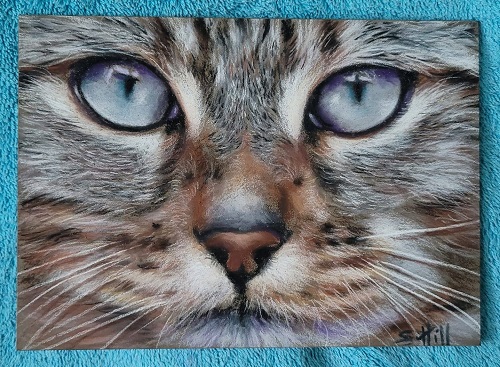
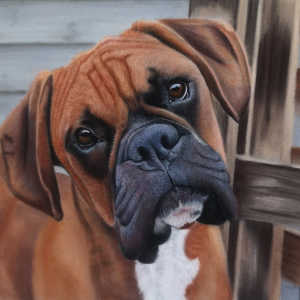
Art by Sue Kerrigan-Harris on Velour Paper
Sue says: ‘This paper gives a soft focus effect and it’s perfect for short haired dogs like boxers and also horses because the paper itself is very similar to their fur. But achieving those eye details take a lot of skill and patience and a sharp pastel pencil. It’s really quite difficult to get whiskers on velour because the light colour of whiskers isn’t always strong enough to go over the top of the other pastel. It’s not impossible, just difficult.
Art by Jude Sullivan on Fabriano Tiziano
Jude says: ‘ I find it takes undercoat well, easily blended as a base, then I can build several layers for depth before putting fine detail over the top with sharp pencil. It is robust enough to allow removal once or twice, too.’
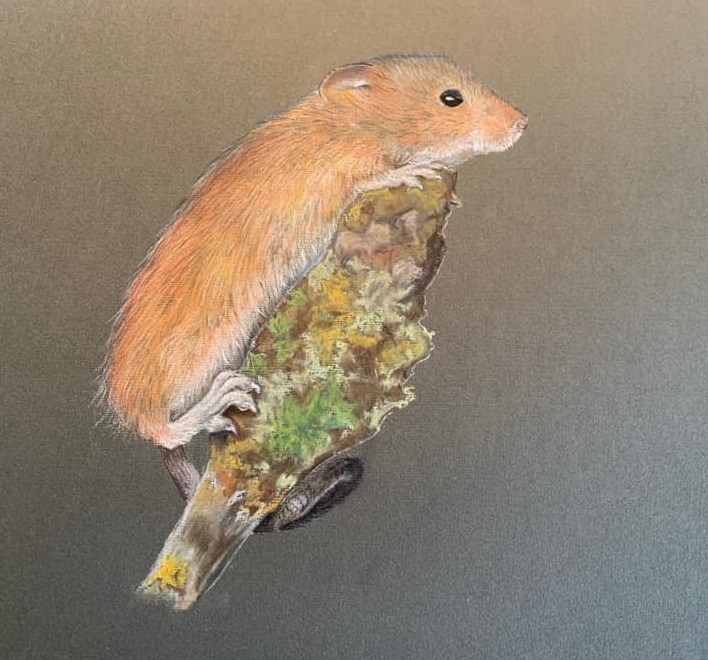
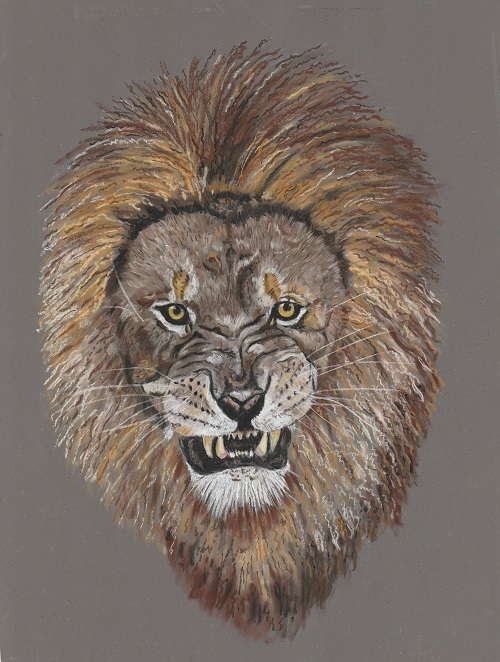
Art by Susan Tack on 1500GRIT Wet & Dry Paper
Susan says: ‘Not classed as archival, but I love using wet/dry 1500 grit. I have done some work on Pastelmat which was acceptable but I just cannot get to like it! Lots of reasons… if they did pads of individual colours, or at least a mix of neutrals it would help. I don’t like the sizes, and the mixed pads are a weird combination of colours, making me feel I’m paying a lot for what I don’t want. I don’t do many backgrounds so covering the original colour is not the answer. Also I can get finer whisker detail with Wet/dry. Cons, Can’t get bigger than A4.’
Art by Sarah Bold on Pastelmat
Sarah says: ‘I love pastelmat but definitely not the white colour, I love it for its layers. Velour paper is so lovely to feel and you can work details into it and some layers although it’s difficult to transfer a drawing on it without getting indentation marks but it’s still beautiful to work with. I have recently tried uart which is nice but have to peg it down as the rolling up drives me mad. I have also tried canson touch which is alright but I haven’t really enjoyed using it however I probably need to give it a chance I like the size pads you can get for it plus the border and you can layer pastel well. A friend got me a pad of ingres fibriano paper and I love it, great for pastel pencils and panpastle you can get a4 and a3 pads which are easier for framing. If like you someone said what’s your favourite between them all with so many I love working with then it has to be pastlemat the greys and blue papers I find the colours just pop and you can use pencils, sticks and pan pastels well with the paper.’
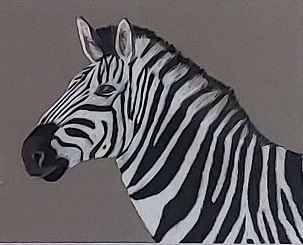
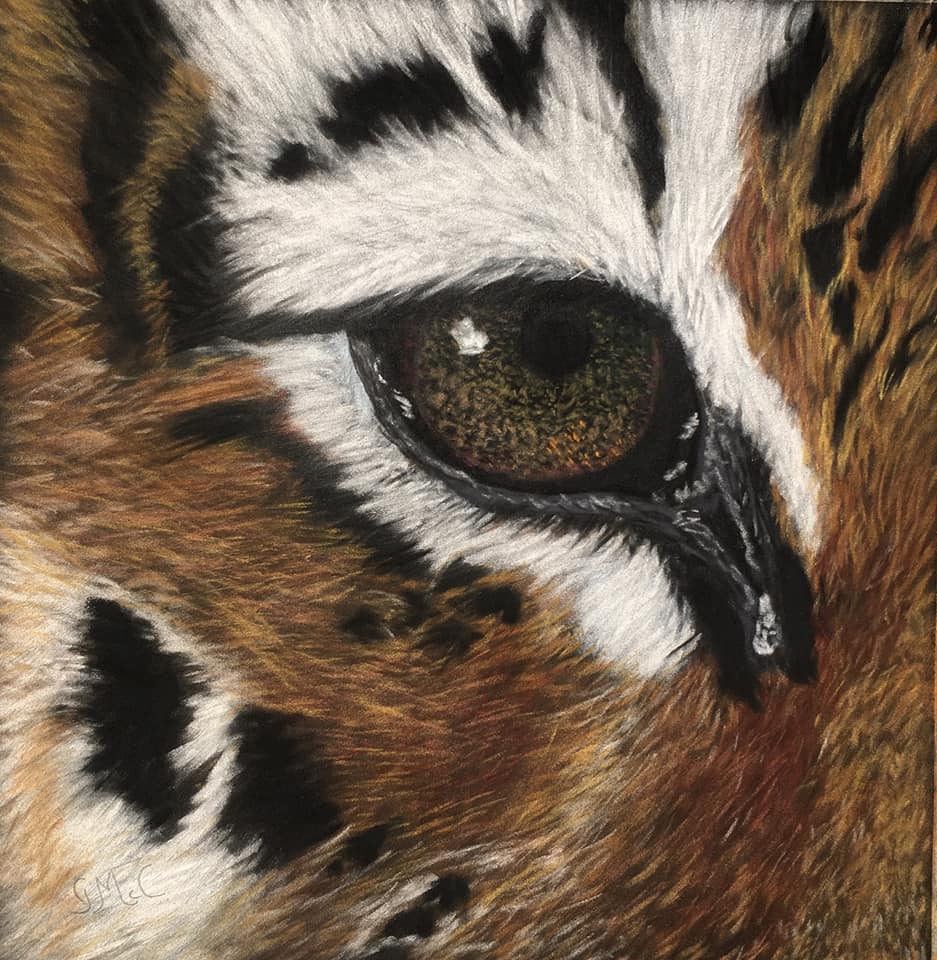
Art by Gerri McCaffery on Suede Mat Board
Gerri says: ‘Suede Mat Board is similar to velour but more rigid, which is good depending on how you work. It’s actually really nice to work on..’
The Suede Mat Board has a velvet surface and shorter close fibres than velour.
Art by Peter Howells on Art Spectrum Colourfix
Peter says: ‘I use Fisher 400 and Art Spectrum Colourfix. The Art Spectrum Colourfix is easier to erase so I tend to use that for portraiture. You also get sharper edges. ‘
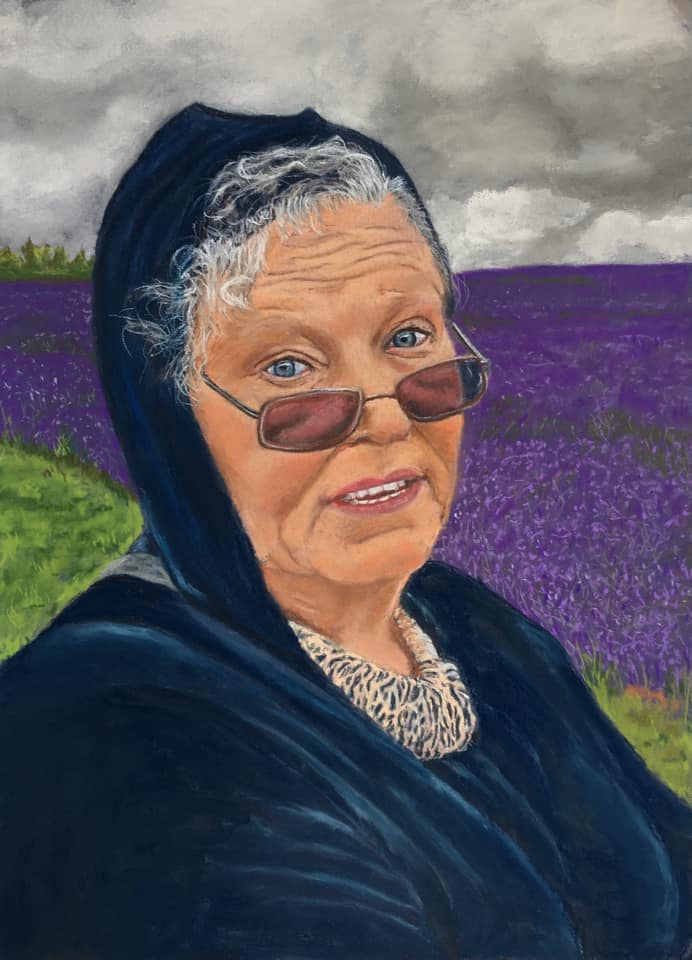
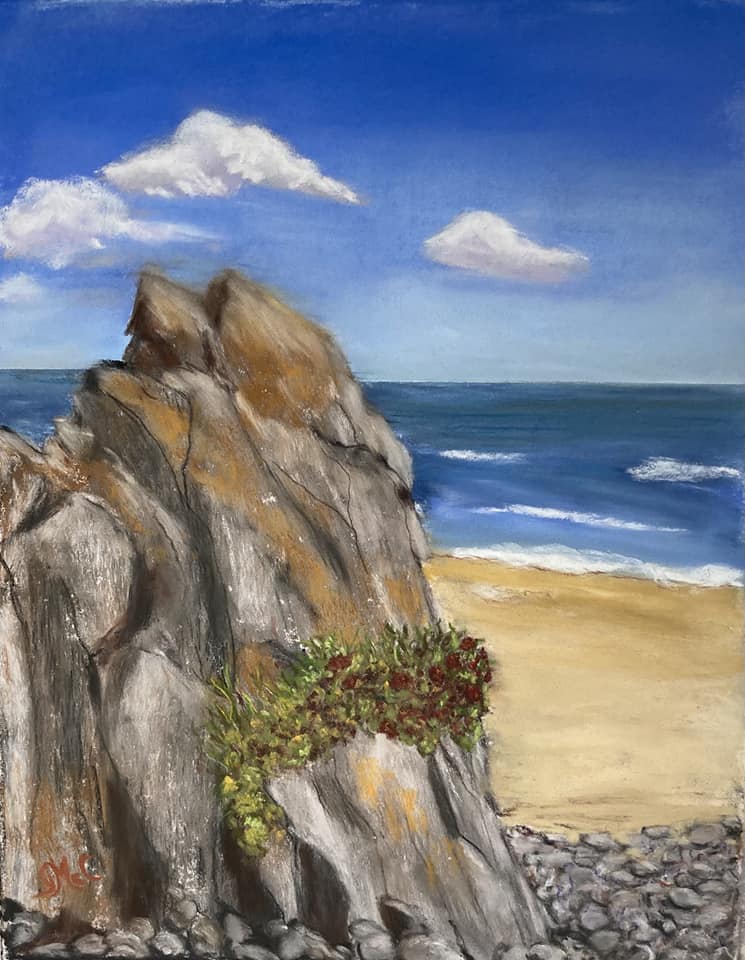
Art by Gerri McCaffery on Pastelmat
Gerri says: ‘I tried a lot of papers and almost gave up on pastels until I discovered Pastelmat. Sanded papers take the layers but are hard on the fingers and use up the sticks very quickly. The more paper-like ones just don’t take the layers the way I like. Pastelmat seems to take unlimited layers, I’m quite heavy handed at times and it has never clogged on me. You can brush off mistakes too. It also doesn’t smudge if you drop it and framing is easy. I love it.’
Art by Suzanne Cross on Sennelier A La Carte
Suzanne says: ‘My favourite is Sennelier card. It holds lots of layers and allows the pastels to be easily blended. Second favourite is Pastelmat.‘
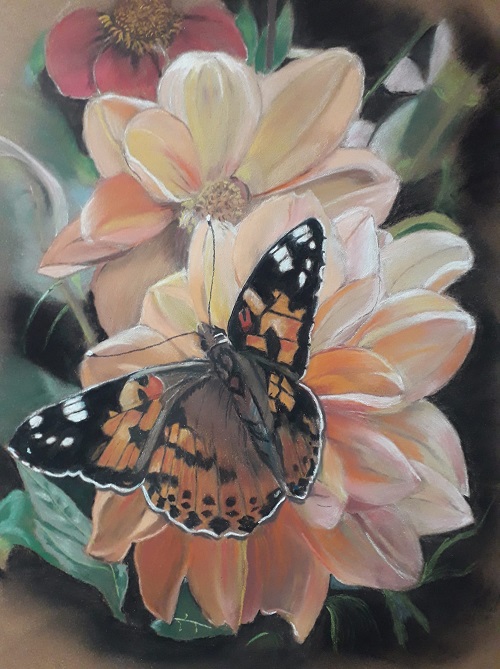
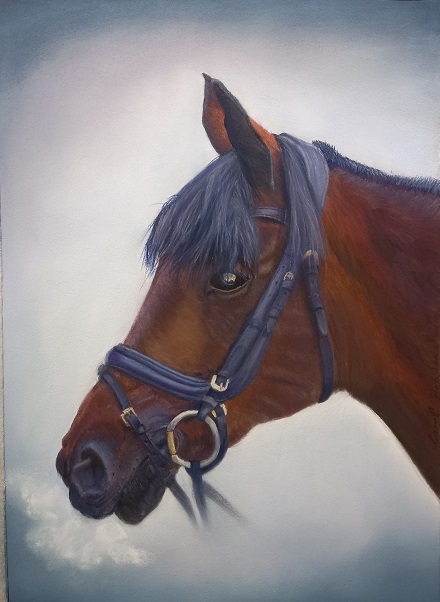
Art by Carol Hebden on Pastelmat
Carol says: ‘When I first started painting with pastels I tried some samples, decided Pastelmat was my favourite and haven’t changed my mind. Love being able to add lots of layers and to blend without getting sore fingers. Have used a combination of pastels with other mediums, such as watercolour, ink, gouache or acrylic.
Carol is one of my students and I’m so proud to see her work develop of the last couple of years. This painting is from my soft pastel horse course
Art by Andy Trumper on UART 400
Andy says: ‘I love UART 400 noir for nocturnes and sunsets, Pastelmat is my favourite overall, and La Carte for when I want to avoid detail, be more expressive and leaning toward abstract.
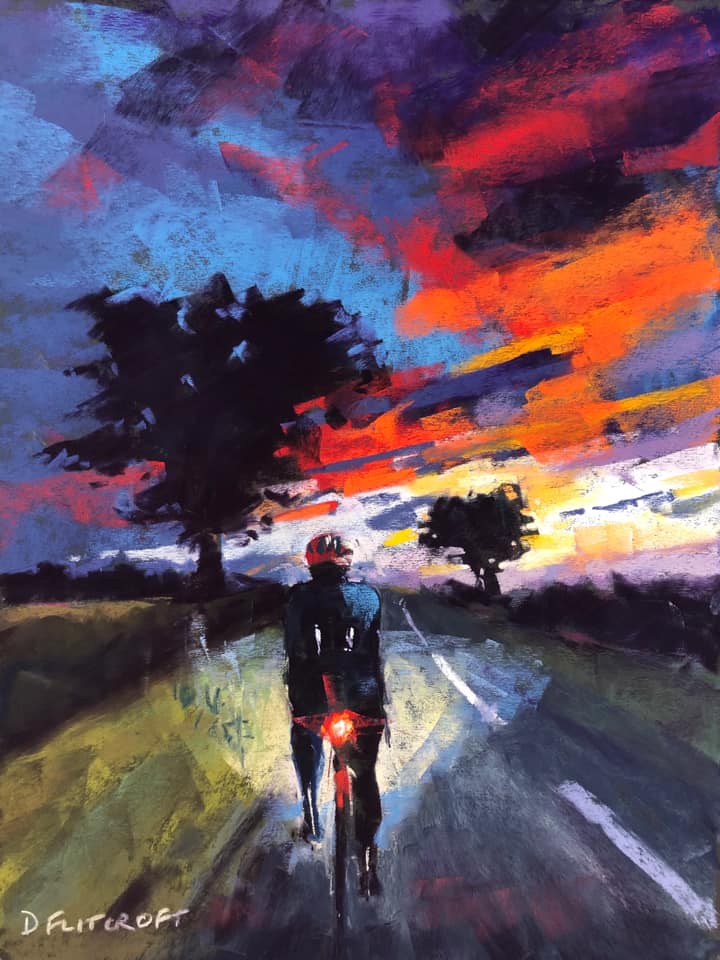
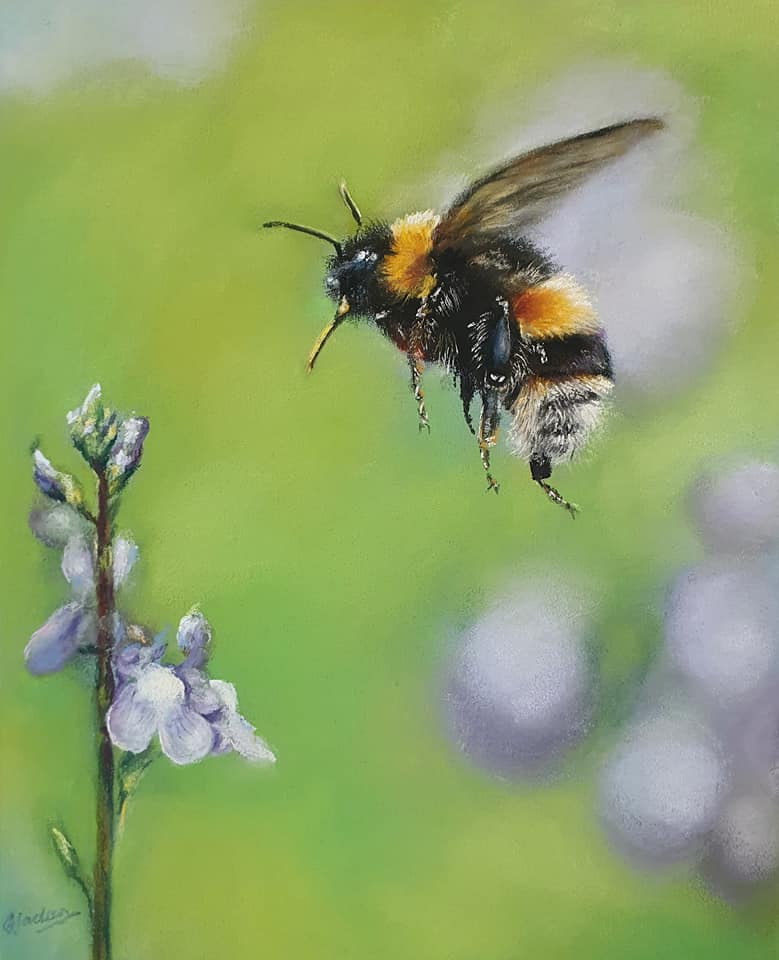
Art by Merlin Jackson on Daley Rowney Murano
Merlin says: ‘I prefer more “typical” pastel paper. I do like velour too though. I think it’s perfectly possible to get detail with that kind of paper. This was done on Daler Rowney Murano which isn’t the greatest paper but still managed to get the detail I wanted’
Art by Christine Clark on Canson Mi-Teintes Touch
Christine says: ‘I have used Art Spectrum Colourfix for years, along with Canson Mi -Teintes Touch, but have recently been introduced to Pastelmat and still getting used to it, but as others have said I think it’s great, and will probably be my go to paper from now on.‘
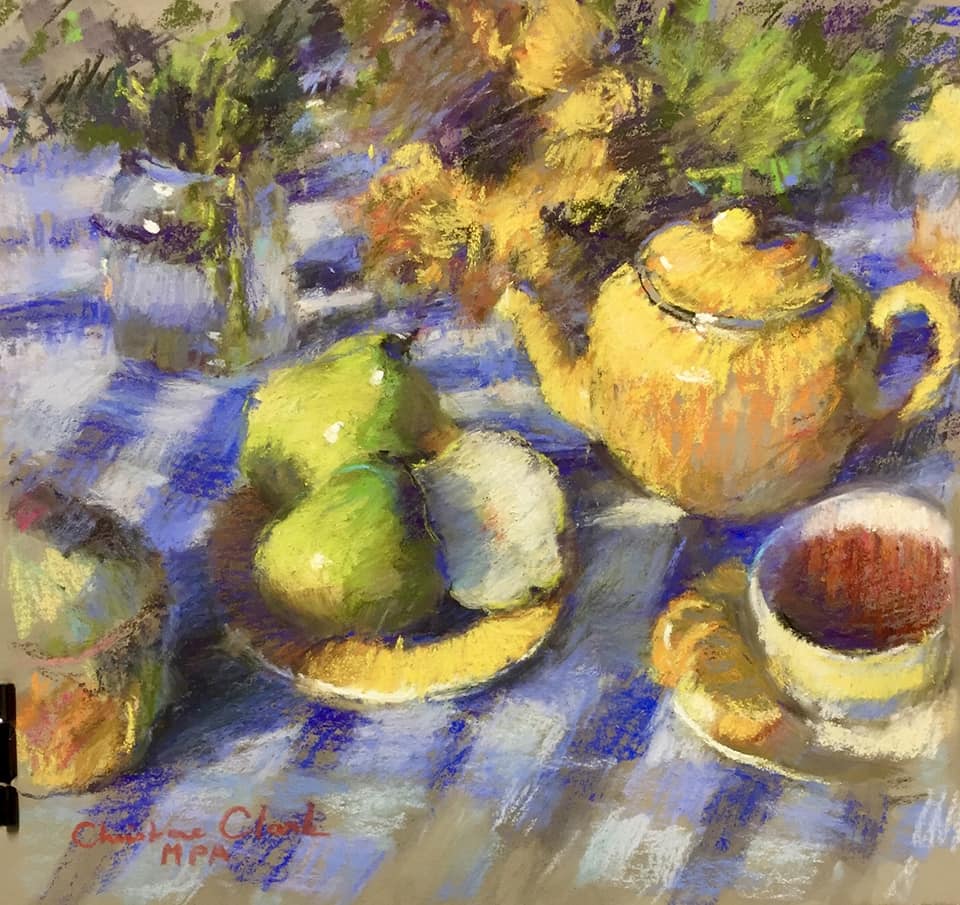
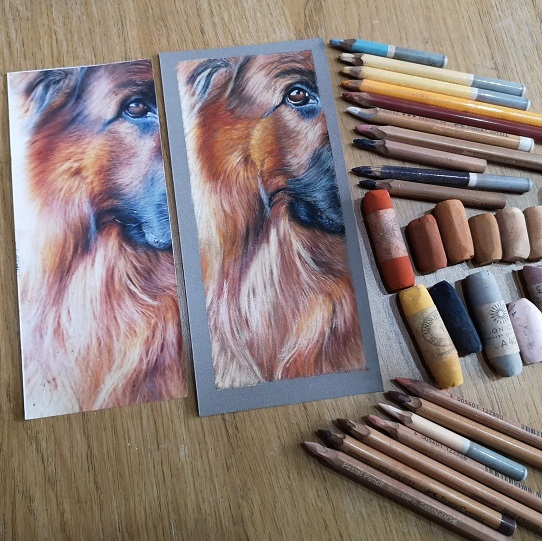
Art by Sue Kerrigan-Harris on Pastelmat
Sue says: ‘Pastelmat is now my preferred paper because I can get the detail I crave without running out of layers. You can also clean the paper with water or brush the pastel off. The soft pastel sings a sweet, sweet song on this paper’
This study is part of the German Shepherd Dog Tutorial
Sue is a Soft Pastel Artist and International Tutor from England UK
She's passionate about soft pastel art and teaching her students from around the globe.
"Art makes my heart sing and my soul smile"
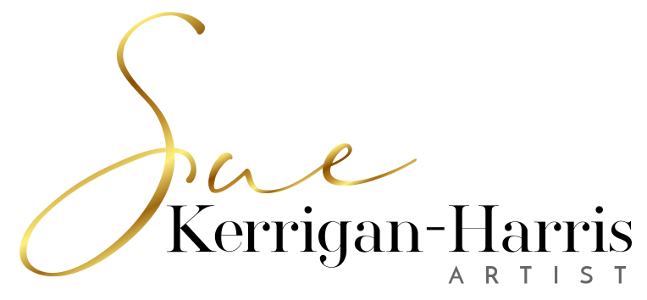
I used to use Wallis Sanded Paper. I don’t see it mentioned here. I have not painted in pastel for so long…been thinking if picking it up again.
Thanks Tonie, I’ll add Wallis paper to the sanded list. There are so many papers around the world and some I have not heard of or indeed forgotten about. also, it is harder to get some papers or prohibitively expensive to get some papers depending on where they are manufactured. A lot of Australians use Art Spectrum Colourfix because it is manufactured by an Australian company.
Hi Sue, my two favorite pastel papers are PastelMat and Fisher 400. . I don’t like UArt mainly because it’s hard to keep flat. There are a few mentioned that I haven’t tried. I started using pastels about three years ago and once I changed to sanded paper it changed my status. I now love it.
Hi Sue, I started using pastelmat in recent years after watching tutorials and reviews on youtube. I did not know specialist papers like this existed. When I inquired about paper for pastels in any art shop I was presented with the very textured paper such as ingress or some other stuff which would have a pattern come through the art work, this is a pet hate of mine. I bought a trial pack of pastelmat and since then my art has improved so much that my previous work would not be believed as the same artist when comparing to what I do today. I am also going to try Fisher 400 and Uart papers. Before I used sugar paper, craft paper and cartridge paper I roughened and sanded down.
Thanks for your insight Mark 🙂